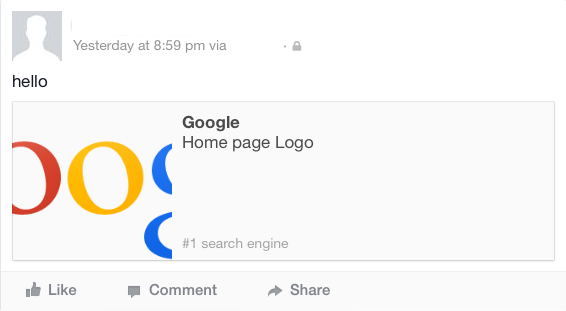EasySocial iOS Library for Twitter and Facebook
This library allows your apps to use Twitter and Facebook with minimal understanding of the relevant SDK. It is super easy to use and elegantly designed. It will save you time.
Many other libraries are overly complicated and offer functionality that you do not need in your app. The included Example Project demonstrates most of the features offered.
EasySocial does only these things:
- Send Plain Tweets
- Send Tweets with images (via a URL or UIImage/NSData)
- Get Data from user's timeline
- Full Facebook Connect (Log In/Log Out and Auto-Log In)
- Fetch User Information (objectID, name etc...)
- Share and Publish messages in user's timeline
Installation
CocoaPods
pod 'EasySocial', '~> 1.0'
First Part
- Add
Social.frameworkto your project - Add
Accounts.frameworkto your project - Drag the
EasySocialfolder into your project (Ensure you checkCopy items into destination group's folder) - Open
<Your Project Name>-Prefix.pchfile in theSupporting FilesFolder within XCode. For XCode 6, you will need to create apchfile from scratch.- Add to the bottom:
//Now you do not need to include those headers anywhere else in your project.
#import "EasyFacebook.h"
#import "EasyTwitter.h"
Second Part
- Download and Add
FacebookSDK.frameworkinto your project. - Register your app with Facebook to get an App ID
- Ensure that the
Bundle IDyou give your app on XCode matches what you register with Facebook - Ensure that you enable
"Single Sign On"in Facebook - Configure the
<Your Project Name>-Info.plistfile by insertingFacebookAppID,FacebookDisplayNameandURL typeskeys - Register your own facebook account as a
Developeraccount. That way you can test your app while you are developing it. In production, Facebook must approve your app to use some features
- Ensure that the
- In your project's
AppDelegate.mfile, include:
- (BOOL)application:(UIApplication *)application openURL:(NSURL *)url sourceApplication:(NSString *)sourceApplication annotation:(id)annotation
{
BOOL wasHandled1 = [EasyFacebook handleOpenURL:url sourceApplication:sourceApplication];
// BOOL wasHandled2 = [GPPURLHandler handleURL:url sourceApplication:sourceApplication annotation:annotation];
// BOOL wasHandled3 = [TumblrAPI handleURL:url];
return wasHandled1;
// return (wasHandled1 || wasHandled2 || wasHandled3);
}
EasyTwitter
Methods
Before you can use EasyTwitter, you must instantiate the EasyTwitter class.
+ (EasyTwitter *)sharedEasyTwitterClient
The class is a singleton class meaning only one is ever created. In practice, the class is automatically instantiated without any action on your part. You can use the class by typing: [EasyTwitter sharedEasyTwitterClient].XXX or [[EasyTwitter sharedEasyTwitterClient] XXX].
Methods - Requesting Permission & Setting Account
Before your app can use Twitter, the user must grant permission to your app.
- (void)requestPermissionForAppToUseTwitterSuccess:(void(^)(BOOL granted, BOOL accountsFound, NSArray *accounts))success failure:(void(^)(NSError *error))failure
BOOL granted will indicate if the user granted permission. If the user does not grant permission, they must go to the iOS built-in Settings App -> Privacy -> Twitter to grant permission in the future.
BOOL accountsFound will indicate if any system-stored Twitter Accounts were found (provided granted==YES). If none were found, remind the user to save their Twitter credentials in Settings App -> Twitter.
NSArray *accounts will contain ACAccount objects. These represent the Twitter accounts found. You can search through all the ACAccount objects to select the desired Twitter account to send tweets from.
ACAccountcontains two properties that are useful:- .username (Type:string i.e finkd)
- .accountDescription (Type:string i.e. @finkd)
Once you discover the required account, set it.
//In practice, set it to the required account. This is the default setting automatically set.
[EasyTwitter sharedEasyTwitterClient].account = [accounts firstObject];
Methods - Sending Tweets
A Tweet is a (max) 140 character message that is propagated to other Twitter users via the Twittersphere. URL links can be embedded in the message. They are automatically detected and minified to save characters. Images can also be attached. All images are uploaded to Twitter's servers.
//Plain Tweet
- (void)sendTweetWithMessage:(NSString *) message twitterResponse:(void(^)(id responseJSON, NSDictionary *JSONError, NSData *responseData, NSHTTPURLResponse *urlResponse, NSError *error))response failure:(void(^)(EasyTwitterIssues issue))failure
//Tweet with an image in *NSData format
- (void)sendTweetWithMessage:(NSString *) message image:(NSData *) image mimeType:(NSString *) mimeType requestShowLoadScreen:(BOOL) show twitterResponse:(void(^)(id responseJSON, NSDictionary *JSONError, NSData *responseData, NSHTTPURLResponse *urlResponse, NSError *error))response failure:(void(^)(EasyTwitterIssues issue))failure
//Tweet with an image referred to by a URL
- (void)sendTweetWithMessage:(NSString *) message imageURL:(NSURL *) imageURL twitterResponse:(void(^)(id responseJSON, NSDictionary *JSONError, NSData *responseData, NSHTTPURLResponse *urlResponse, NSError *error))response failure:(void(^)(EasyTwitterIssues issue))failure
(NSString *) message is the message to tweet.
(NSData *) image refers to an image. If you have a UIImage object, it must be converted to a NSData object by using UIImageJPEGRepresentation() or UIImagePNGRepresentation().
(NSString *) mimeType refers to the Mime Type of the image. It should be one of image/png, image/jpeg, or image/gif. If unspecified, image/png will be assumed.
(NSURL *) imageURL refers to the URL address of the image file. It's Mime Type will be guessed by the file's extension.
(BOOL) show is a private argument. Always set it to YES.
NSDictionary *JSONError is part of the response back from Twitter's REST API. If JSONError == nil, the tweet was posted successfully. If it is not nil,there was an issue.
The issue can be determined by reading the error code and error message.
//pseudo code
int errorCode = [[JSONError objectForKey:@"code"] intValue]; //JSON error code as opposed to HTTP error code
NSString *errorMessage = [JSONError objectForKey:@"message"];
- 187 indicates a duplicate tweet.
- 186 indicates the tweet was too long (over 140 characters).
EasyTwitterIssues issue is returned by the failure block. It represents an error before Twitter's REST API is even called.
If issue == EasyTwitterNoAccountSet, it means that you attempted to send a tweet without setting a Twitter account.
Methods - Timeline
A user's home-timeline represents the most recent tweets and retweets. It should be noted that the home-timelineis different from the user-timeline.
- (void)loadTimelineWithCount:(int) count completion:(void (^)(NSArray *data, NSError *error))completion
(int) count refers to how many recent items from the home-timeline you want returned. The maximum is 200.
NSArray *data will contain NSDictionary objects which represent an item from the timeline. The most recent item is atindex==0.During development, you can observe the contents of each item using: NSLog(@"data: %@", data)
Finally you can extract the desired data like this:
//pseudo code
cell.textLabel.text = [data[row] objectForKey:@"text"]; //Main contents of item
cell.detailTextLabel.text = [[data[row] objectForKey:@"user"] objectForKey:@"""screen_name"""]; //Screen name of owner of item
Notifications
EasyTwitterPermissionGrantedNotification - Posted when the user grants permission to access system-stored Twitter accounts. It does not imply that any twitter accounts were found.
EasyTwitterAccountSetNotification - Posted when you set anACAccountobject as the Twitter account to tweet from. This notification is also posted when the default Twitter account is set automatically (without any action on your part).
EasyTwitterTweetSentNotification - Posted when a tweet was successfully sent. It is usually more useful to monitor the NSDictionary *JSONError argument in the response callback block of the sendTweetWithMessage: methods. A nil error response indicates a successful tweet.
EasyTwitterDelegate
Both methods prescribed in the protocol are optional. You will have to set the delegate property appropriately to subscribe to the protocol. It may be useful to implement them as demonstrated in the accompanyingExample Project.
showLoadingScreen: is called before a potentially time-consuming activity begins. hideLoadingScreen: is called after a time-consuming activity finishes.
It is expected that you show the user that background activity is occurring via a UI element.
The delegate methods are called before and after:
requestPermissionForAppToUseTwitterSuccess:failure:sendTweetWithMessage:image:mimeType:requestShowLoadScreen:twitterResponse:failure:sendTweetWithMessage:imageURL:twitterResponse:failure:sendTweetWithMessage:twitterResponse:failure:loadTimelineWithCount:completion:
EasyFacebook
Methods
Before you can use EasyFacebook, you must instantiate the EasyFacebook class.
+ (EasyFacebook *)sharedEasyFacebookClient
The class is a singleton class meaning only one is ever created. In practice, the class is automatically instantiated without any action on your part. You can use the class by typing: [EasyFacebook sharedEasyFacebookClient].XXX or [[EasyFacebook sharedEasyFacebookClient] XXX].
Methods - Log in & Log out
Before you can interact with the FacebookSDK, you must have a logged in user.
- (void)openSession //For logging in
- (void)closeSession //For logging out
- (BOOL)isLoggedIn //For checking logged in status
By calling the openSession method, the user will undergo the standard logging in process. This usually involves opening up the official Facebook app (if installed). Otherwise Safari browser will be opened instead. The user will be asked to grant permission to your app to access their details. Once approved, any future calls to openSession will briefly open up the Facebook app but will almost immediately transfer back to your app - since the user had already granted approval in the past (provided the approval is not later revoked).
The closeSession method will immediately log out the user.
The (BOOL)isLoggedIn method will return whether the user is currently logged in or out.
If the user logs in and later exits your app, a cached token will usually be saved locally. When your app is opened again, the user will usually not have to log in again. This is part of the Auto-Log In feature.
For security reasons, if you want to turn off Auto-Log In behaviour, you can listen to UIApplicationWillTerminateNotification and call closeSession to log out the user.
When the user is being logged in, the FacebookSDK requires the initial permissions requested. The default permissions are:
If you want to modify the permissions requested, before calling openSession you can set readPermissions:
//Set the readPermissions to what ever you want
[EasyFacebook sharedEasyFacebookClient].readPermissions = @[@"public_profile", @"email", @"user_friends"];
Read the Notifications section below if you want to what know state changes are available to you.
Methods - Fetching basic user information
After the user logs in, a call to fetch the user's basic information is automatically done. However, if you want the latest information on demand then call this method.
- (void)fetchUserInformation
Once the information arrives, the EasyFacebookUserInfoFetchedNotification notification is posted. Once posted, you can extract the latest details using these properties:
@property NSString *UserEmail- Only available ifemailpermission is requested. By default, it is requested.@property NSString *UserFirstName@property NSString *UserGender@property NSString *UserObjectID- usually referred to asid(unique to the user - store in databases)@property NSString *UserLastName@property NSString *UserLink@property NSString *UserLocale@property NSString *UserName@property NSString *UserTimeZone@property NSString *UserVerified
Methods - Publishing Rights
Publishing to the timeline requires the publish_actions permission. You will also require Facebook approval once your app is ready to go to production.
- (BOOL)isPublishPermissionsAvailableQuickCheck
- (void)isPublishPermissionsAvailableFullCheck:(void(^)(BOOL result, NSError *error))responseHandler
- (void)requestPublishPermissions:(void(^)(BOOL granted, NSError *error))responseHandler
(BOOL)isPublishPermissionsAvailableQuickCheck checks if publish_actions permission is granted to the current access token. It is 99% accurate since the permissions granted could have changed since the access token was issued. The permissions could also be changed by the user via the Facebook website external to your app. The method will immediately return however since it does not make any REST API calls.
(void)isPublishPermissionsAvailableFullCheck will perform a 100% accurate check for publish_actions permission. It will make a REST API call and will return with a BOOL result response. If result==YES, then publishing permission is available.
If publishing permission is not available, you will have to request it by calling (void)requestPublishPermissions method. A response where granted==YES will indicate that the user has granted permission.
Methods - Publishing Content
To publish and share content, publish_actions permission is required. By calling the publishStoryWithParams:completion: method below, it automatically also calls the requestPublishPermissions: method.
- (void)publishStoryWithParams:(NSDictionary *)params completion:(void(^)(BOOL success, NSError *error))completion
(NSDictionary *)params can have these parameters:
- link - the url we want to share
- name - a title
- caption - a subtitle
- picture - the url of a thumbnail to associate with the post
- description - a snippet of text describing the content of the link
- message - main message appears above everything else
BOOL success will be the response in the completion block. If success==YES, the share post was successful.
As an example:
NSDictionary *params = @{@"link" : @"http://www.google.com",
@"name" : @"Google",
@"caption" : @"#1 search engine",
@"picture" : @"https://www.google.com/images/srpr/logo11w.png",
@"description" : @"Home page Logo",
@"message" : @"hello"
};
The output will be:
Notifications
EasyFacebookLoggedInNotification - Posted when the user successfully logs in. The notification is also posted after an auto-log in.
EasyFacebookLoggedOutNotification - Posted when the user logs out intentionally or due to unexpected reasons.
EasyFacebookUserInfoFetchedNotification - Posted when the user's basic information becomes available. This will happen automatically shortly after the user logs in, or after fetchUserInformation method is explicitly called. See above for information on what basic information is available.
EasyFacebookUserCancelledLoginNotification - Posted when the user is given the opportunity to log in but decides to cancel the process. The user is usually taken outside the app to the official Facebook app to log in. If the app is not installed, Safari browser is opened with the log in dialog shown via a website.
EasyFacebookPublishPermissionGrantedNotification - Posted when the user grants permission for the app to publish on their timeline.
EasyFacebookPublishPermissionDeclinedNotification - Posted when the user declines to grant permission for the app to publish on their timeline.
EasyFacebookStoryPublishedNotification - Posted when the share attempt is successfully published on the user's timeline.
EasyFacebookDelegate
Both methods prescribed in the protocol are optional. You will have to set the delegate property appropriately to subscribe to the protocol. It may be useful to implement them as demonstrated in the accompanyingExample Project.
showLoadingScreen: is called before a potentially time-consuming activity begins. hideLoadingScreen: is called after a time-consuming activity finishes.
It is expected that you show the user that background activity is occurring via a UI element.
The delegate methods are called before and after:
publishStoryWithParams:completion:
Diagnostics
@property BOOL preventAppShutDown - iOS 8 incorporates a different Memory Management Policy. If you find that your app is getting shut down by iOS after the user is taken to the Facebook app as part of the log in process, then set this property to YES.
@property BOOL facebookLoggingBehaviourOn - For diagnostic purposes, if you want the FacebookSDK to log full details (in the debug window) on what it is doing behind the scenes, then set this property to YES.
Final Notes
If you found this library useful, please Star it on github. Feel free to fork or provide pull requests. Any bug reports will be warmly received.





